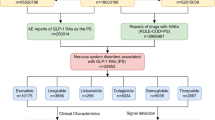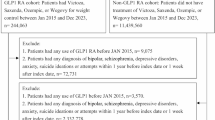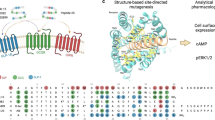Abstract
Glucagon-like peptide-1 (GLP-1) receptor agonists, widely prescribed for type 2 diabetes and weight management, are known for their metabolic benefits but may have unrecognized side effects. This study investigates the association between GLP-1 receptor agonists and male sexual dysfunction using data from the FDA Adverse Event Reporting System (FAERS). Reports from Q4 2003 to Q1 2024 were analyzed using the OpenVigil 2.1 platform to identify male patients experiencing orgasmic dysfunction, erectile dysfunction, or decreased libido linked to GLP-1 receptor agonists (tirzepatide, semaglutide, dulaglutide, exenatide, lixisenatide, and liraglutide). After cleaning duplicate entries, disproportionality measures (reporting odds ratio (ROR), proportional reporting ratio (PRR), and relative reporting ratio (RRR)) were calculated, with Evans’ criteria applied to assess signal significance. Among 182 cases identified, patients were predominantly aged 40–60 years, with exenatide accounting for 24.2% of reports, followed by semaglutide (21.4%). Diabetes was the most common indication (43.9%). Despite statistically significant chi-squared values (P < 0.0001), low ROR (0.41, 95% Confidence interval (CI): 0.36–0.48), PRR (0.41, 95% CI: 0.36–0.48), and RRR (0.42, 95% CI: 0.36–0.48) suggest a weak association. These findings underscore the need for monitoring as GLP-1 use expands, though overall patient risk remains low.
This is a preview of subscription content, access via your institution
Access options
Subscribe to this journal
Receive 12 print issues and online access
$259.00 per year
only $21.58 per issue
Buy this article
- Purchase on SpringerLink
- Instant access to full article PDF
Prices may be subject to local taxes which are calculated during checkout

Similar content being viewed by others
Data availability
The datasets used and analyzed during the current study are available from the corresponding author upon reasonable request.
References
Mashayekhi M, Beckman JA, Nian H, Garner EM, Mayfield D, Devin JK, et al. Comparative effects of weight loss and incretin-based therapies on vascular endothelial function, fibrinolysis and inflammation in individuals with obesity and prediabetes: a randomized controlled trial. Diabetes Obes Metab. 2023;25:570–80. https://doi.org/10.1111/dom.14903
Ayoub M, Aibani R, Dodd T, Ceesay M, Bhinder M, Faris C, et al. Risk of esophageal and gastric cancer in patients with type 2 diabetes receiving glucagon-like peptide-1 receptor agonists (GLP-1 RAs): A national analysis. Cancers. 2024;16:3224. https://doi.org/10.3390/cancers16183224
Montero A, Sparks G, Presiado M, Hamel L.: KFF health tracking poll may 2024: the public’s use and views of GLP-1 drugs. https://www.kff.org/health-costs/poll-finding/kff-health-tracking-poll-may-2024-the-publics-use-and-views-of-glp-1-drugs/ (2024). Accessed May 24 2024.
Lee JM, Sharifi M, Oshman L, Griauzde DH, Chua K-P. Dispensing of glucagon-like peptide-1 receptor agonists to adolescents and young adults, 2020–2023. JAMA. 2024;331:2041–3. https://doi.org/10.1001/jama.2024.7112
Liu L, Chen J, Wang L, Chen C, Chen L. Association between different GLP-1 receptor agonists and gastrointestinal adverse reactions: a real-world disproportionality study based on FDA adverse event reporting system database. Front Endocrinol. 2022;13:1043789. https://doi.org/10.3389/fendo.2022.1043789
Almandoz JP, Lingvay I, Morales J, Campos C. Switching between glucagon-like peptide-1 receptor agonists: rationale and practical guidance. Clin Diabetes. 2020;38:390–402. https://doi.org/10.2337/cd19-0100
Vestlund J, Jerlhag E. The glucagon-like peptide-1 receptor agonist, exendin-4, reduces sexual interaction behaviors in a brain site-specific manner in sexually naive male mice. Horm Behav. 2020;124:104778 https://doi.org/10.1016/j.yhbeh.2020.104778
Vestlund J, Jerlhag E. Glucagon-like peptide-1 receptors and sexual behaviors in male mice. Psychoneuroendocrinology. 2020;117:104687. https://doi.org/10.1016/j.psyneuen.2020.104687
Georgiadis JR, Reinders AA, Van der Graaf FH, Paans AM, Kortekaas R. Brain activation during human male ejaculation revisited. Neuroreport. 2007;18:553–7. https://doi.org/10.1097/WNR.0b013e3280b10bfe
Rowland D, McMahon CG, Abdo C, Chen J, Jannini E, Waldinger MD, et al. Disorders of orgasm and ejaculation in men. J Sex Med. 2010;7:1668–86. https://doi.org/10.1111/j.1743-6109.2010.01782.x
Jie HW, Jie W, Jianxiong M, Xin Z, Runnan X, Yijia F, et al. Mechanism of denervation muscle atrophy mediated by Ach/p38/MAPK pathway in rats with erectile dysfunction caused by nerve injury. Exp Cell Res. 2024;442:114283. https://doi.org/10.1016/j.yexcr.2024.114283
Jin X, Sun L, Li H, Liu Y. Association between the composite dietary antioxidant index and erectile dysfunction in US men: a cross-sectional study. J Health Popul Nutr. 2024;43:184. https://doi.org/10.1186/s41043-024-00653-w
Quinta Gomes AL, Nobre PJ. Prevalence of sexual problems in Portugal: results of a population-based study using a stratified sample of men aged 18 to 70 years. J Sex Res. 2014;51:13–21. https://doi.org/10.1080/00224499.2012.744953
Laumann EO, Paik A, Rosen RC. Sexual dysfunction in the United States: prevalence and predictors. JAMA. 1999;281:537–44. https://doi.org/10.1001/jama.281.6.537
Mark KP, Arenella K, Girard A, Herbenick D, Fu J, Coleman E. Erectile dysfunction prevalence in the United States: report from the 2021 national survey of sexual wellbeing. J Sex Med. 2024;21:296–303. https://doi.org/10.1093/jsxmed/qdae008
Evans SJ, Waller PC, Davis S. Use of proportional reporting ratios (PRRs) for signal generation from spontaneous adverse drug reaction reports. Pharmacoepidemiol Drug Saf. 2001;10:483–6. https://doi.org/10.1002/pds.677
Rothman KJ, Lanes S, Sacks ST. The reporting odds ratio and its advantages over the proportional reporting ratio. Pharmacoepidemiol Drug Saf. 2004;13:519–23. https://doi.org/10.1002/pds.1001
Böhm R.: Primer on disproportionality analysis. https://openvigil.sourceforge.net/doc/DPA.pdf (2018). Accessed 03/17/2025.
Altman DG, Bland JM. Absence of evidence is not evidence of absence. BMJ. 1995;311:485. https://doi.org/10.1136/bmj.311.7003.485
Watanabe JH, Kwon J, Nan B, Reikes A. Trends in glucagon-like peptide 1 receptor agonist use, 2014 to 2022. J Am Pharm Assoc. 2024;64:133–8. https://doi.org/10.1016/j.japh.2023.10.002
Thorp HH. More questions than answers. Science. 2023;382:1213 https://doi.org/10.1126/science.adn3693
(FDA) USFaDA: FDA approves new drug treatment for chronic weight management, first since 2014. https://www.fda.gov/news-events/press-announcements/fda-approves-new-drug-treatment-chronic-weight-management-first-2014 (2021). Accessed Nov 2 2024.
(FDA) USFaDA: Drug approval package byetta (Exenatide) injection. https://www.accessdata.fda.gov/drugsatfda_docs/nda/2005/021773_byettatoc.cfm#:~:text=Approval%20Date%3A%204%2F28%2F2005 (2005). Accessed Nov 2 2024.
Jagielski D.: These were the top-selling GLP-1 drugs last quarter from Eli Lilly and Novo Nordisk. https://finance.yahoo.com/news/were-top-selling-glp-1-120000543.html (2024). Accessed Nov 2, 2024.
(FDA) USFaDA: Drug trials snapshots: MOUNJARO. https://www.fda.gov/drugs/drug-approvals-and-databases/drug-trials-snapshots-mounjaro (2022). Accessed Nov 2 2024.
Rodriguez PJ, Goodwin Cartwright BM, Gratzl S, Brar R, Baker C, Gluckman TJ, et al. Semaglutide vs Tirzepatide for weight loss in adults with overweight or obesity. JAMA Intern Med. 2024;184:1056–64. https://doi.org/10.1001/jamainternmed.2024.2525
Able C, Liao B, Saffati G, Maremanda A, Applewhite J, Nasrallah AA, et al. Prescribing semaglutide for weight loss in non-diabetic, obese patients is associated with an increased risk of erectile dysfunction: A TriNetX database study. Int J Impot Res. 2024. https://doi.org/10.1038/s41443-024-00895-6
Giagulli VA, Carbone MD, Ramunni MI, Licchelli B, De Pergola G, Sabba C, et al. Adding liraglutide to lifestyle changes, metformin and testosterone therapy boosts erectile function in diabetic obese men with overt hypogonadism. Andrology. 2015;3:1094–103. https://doi.org/10.1111/andr.12099
Bajaj HS, Gerstein HC, Rao-Melacini P, Basile J, Colhoun H, Conget I, et al. Erectile function in men with type 2 diabetes treated with dulaglutide: an exploratory analysis of the REWIND placebo-controlled randomised trial. Lancet Diabetes Endocrinol. 2021;9:484–90. https://doi.org/10.1016/S2213-8587(21)00115-7
Hathaway JT, Shah MP, Hathaway DB, Zekavat SM, Krasniqi D, Gittinger JW Jr., et al. Risk of nonarteritic anterior ischemic optic neuropathy in patients prescribed semaglutide. JAMA Ophthalmol. 2024;142:732–9. https://doi.org/10.1001/jamaophthalmol.2024.2296
Arillotta D, Floresta G, Papanti Pelletier GD, Guirguis A, Corkery JM, Martinotti G, et al. Exploring the potential impact of GLP-1 receptor agonists on substance use, compulsive behavior, and libido: insights from social media using a mixed-methods approach. Brain Sci. 2024;14:617 https://doi.org/10.3390/brainsci14060617
Fu Z, Gong L, Liu J, Wu J, Barrett EJ, Aylor KW, et al. Brain endothelial cells regulate glucagon-like peptide 1 entry into the brain via a receptor-mediated process. Front Physiol. 2020;11:555. https://doi.org/10.3389/fphys.2020.00555
Lengsfeld S, Hasenbohler F, Probst L, Baur F, Emara Y, Bathelt C, et al. Effects of glucagon-like peptide-1 analogs on sexual desire: a randomized, double-blind, placebo-controlled crossover trial. Endocr Abstr. 2023. https://doi.org/10.1530/endoabs.90.P69.
Brunetti L, Orlando G, Recinella L, Leone S, Ferrante C, Chiavaroli A, et al. Glucagon-like peptide 1 (7–36) amide (GLP-1) and exendin-4 stimulate serotonin release in rat hypothalamus. Peptides. 2008;29:1377–81. https://doi.org/10.1016/j.peptides.2008.04.007
Bate A, Evans SJ. Quantitative signal detection using spontaneous ADR reporting. Pharmacoepidemiol Drug Saf. 2009;18:427–36. https://doi.org/10.1002/pds.1742
Armstrong RA. When to use the Bonferroni correction. Ophthalmic Physiol Opt. 2014;34:502–8. https://doi.org/10.1111/opo.12131
Author information
Authors and Affiliations
Contributions
APL: Conceptualization, Data curation, Formal analysis, Methodology, Supervision, Validation, Visualization, Writing; ALC: Conceptualization, Writing, review & editing. SB: Methodology, Visualization, Writing, review & editing; ERS: Writing draft, review & editing, JS: Writing draft, review & editing; YSC: Supervision, Writing, review & editing, FDG: Writing draft, review & editing; MS: review & editing; MLE: Conceptualization, Methodology, Supervision, Validation, Visualization, review & editing.
Corresponding author
Ethics declarations
Competing interests
The authors declare no competing interests.
Ethics approval and consent to participate
All methods were performed in accordance with relevant guidelines and regulations. This study utilized publicly available, de-identified data from the FDA Adverse Event Reporting System (FAERS), and therefore did not involve direct interaction with human participants or identifiable private information. As such, the Stanford University School of Medicine Institutional Review Board determined that the study was exempt from review (IRB exemption granted; no reference number applicable for de-identified dataset studies). Because the research did not involve the collection of identifiable human data or images, informed consent to participate and consent for publication were not required.
Additional information
Publisher’s note Springer Nature remains neutral with regard to jurisdictional claims in published maps and institutional affiliations.
Rights and permissions
Springer Nature or its licensor (e.g. a society or other partner) holds exclusive rights to this article under a publishing agreement with the author(s) or other rightsholder(s); author self-archiving of the accepted manuscript version of this article is solely governed by the terms of such publishing agreement and applicable law.
About this article
Cite this article
Pourabhari Langroudi, A., Chen, A.L., Basran, S. et al. Male sexual dysfunction associated with GLP-1 receptor agonists: a cross-sectional analysis of FAERS data. Int J Impot Res 37, 661–667 (2025). https://doi.org/10.1038/s41443-025-01061-2
Received:
Revised:
Accepted:
Published:
Issue date:
DOI: https://doi.org/10.1038/s41443-025-01061-2
This article is cited by
-
Comment on: Male sexual dysfunction associated with GLP-1 receptor agonists: a cross-sectional analysis of FAERS data
International Journal of Impotence Research (2025)
-
Comment on: Male sexual dysfunction associated with GLP-1 receptor agonists: a cross-sectional analysis of FAERS data
International Journal of Impotence Research (2025)
-
Response to Comment on: Male sexual dysfunction associated with GLP-1 receptor agonists: a cross-sectional analysis of FAERS data
International Journal of Impotence Research (2025)
-
Response to Comment on: Male sexual dysfunction associated with GLP-1 receptor agonists: a cross-sectional analysis of FAERS data
International Journal of Impotence Research (2025)



